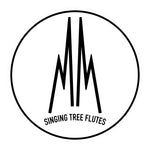Here at Singing Tree Flutes we not only offer traditional Native American style flutes, but we are perpetually innovating in regards to the scales we incorporate, the woods we use and the different flute types and decoration that we create. We thoroughly enjoy creatively expanding our flutes to new heights.
We understand that browsing our website can be overwhelming to those who are new to us and Native American style flutes in general.
We hope this page will make it easier for you to make a well informed decision when ordering your flutes.
We love sharing are unique flute creations with you. We are beginning to move away from custom orders, however, if we cannot accept your custom order, we can always put you on a "Wish List" and notify you either when we are ready to accept a more customized order, or when we have something similar to your desired flute in stock!
To get inspired, view our shop and gallery for all sorts of possibilities!
Historically, cedar has been an important wood for the construction of Native American style flutes. Today we see flutes being built with many different soft and hardwoods, as flute makers continue to innovate and explore.
At STF we try to be as environmentally friendly as possible with the wood that we use in our flutes. That means, we have stopped buying wood that is on endangered hardwood lists and we veer away from woods that are being unsustainably harvested.
Luckily for us, we live in a part of the country that gives us access to many fine hard and softwoods. One of the places we get our wood is Sustainable NW Wood. They offer sustainably harvested wood, along with reclaimed wood. These include juniper, myrtle, figured walnut, maple, madrone and cedar, among others.
We also offer non-local hardwoods, which we have verified are not endangered, and have programs in place for reforestation. We strive to use "reclaimed" wood whenever possible, as well. Canary wood, limba, purple heart, paduk, zircote, koa and bocote are some of the exotic hardwoods we work with. We have since stopped working with Gabon and Ebony (aside from reclaimed), because of its endangered status.
We also love to work with American hardwoods like cherry, walnut and maple. Especially figured woods whenever possible!
Cedar of course is a mainstay for us, western cedar, aromatic cedar and Alaskan cedar, but we offer other softwoods including juniper, and the occasional fir, redwood or pine.
Our flutes come in several different types. There are many different ways a flute can be constructed, to produce a variety of different tones, pitches and chords. The standard Native American style flute is just the tip of the iceberg, when it comes to Singing Tree Flute creations. Here is what we currently offer.
Single Chamber Flute
These are our standard Native American style flutes. They have one chamber. These flutes are monophonic, meaning they can play only one note at a time.
Drone Flutes
These flutes come with multiple chambers. Our Double Drone comes with two chambers and our Triple Drone comes with three. These flutes are polyphonic, meaning they can play more than one note at a time. The double can play two notes at a time, and the triple can play three. They have a mesmerizing sound and are often used for meditation, sound healing or other ceremonial practices.
Double Drones
Standard Double Drone Flutes
These flutes have one chamber that is the drone ( one note ) and another chamber that plays the full scale. The drone plays the fundamental note of the key your flute is in, (lowest note of the flute).
Alternating Drones
These flutes have one chamber with a scale and the other chamber with one or two playing holes that can change the note of that chamber to the 5th or 4th scale degree. This is the next level up on our drones as it offers more options than the Standard Double Drone. This flute will take more time to master as it has a more complex harmonic structure.
Harmony Drones
These flutes have two different key scales on either chamber that will harmonize with each other. They often have one side that is shorter than the other. There are typically 3-4 notes on each side that all harmonize with the other, creating chord like melodies. This is actually a very simplistic flute that creates a sweet, meditative tone
Triple Drones
Triple Drone Flutes
These flutes have three chambers that combine all of the flutes above into one instrument. This is an awesome instrument with limitless possibilities!
Bass & Contrabass
Bass & Contrabass
These flutes have low resonant keys, that are big and bassy. They are sometimes so large, (up to 4 feet), that they have a back-blown mouthpiece and customized fingering. They can be single or double chambered.
We are always innovating and working on crazy new combinations of flute types. These flutes expand even more possibilities than what is described above. These can be found on our YouTube channel and by browsing our website! Our flutes can be made in different scales. Look below to see descriptions of the most common flute scales we use.
Scales
NAF minor (Standard Native American Flute) is the most popular and most common scale that you will find with Native American Flutes. At Singing Tree Flutes we are constantly expanding our repertoire. If you are interested in learning more about NAF minor, or if you are searching for something different, take a look at the scales we use on our flutes below.
NAF Minor
The NAF minor is the tuning that most Native American Flutes in general come with. It is a minor pentatonic with the option of playing a flat sixth. The pentatonic scale is ancient. It predates Pythagoras, the Babylonians and virtually every other culture all the way back to early bird bone flutes.
Major
The Major scale(Do, Re, Mi) is the most recognizable of all the scales we use world wide. You have been hearing it from the moment you were born, it plays a part in our lives without you even knowing it. Happy, bright, airy and content, are words to describe this scale.
North American Indigenous (NAI)
This scale was played by the indigenous people of the Great Plains. It consists of six notes and has a distinct sound. It can modulate between a more contemplative melancholy sound and a bold, adventurous song.
Aeolian
The name Aeolian was originally derived from the inhabitants of Aeolis. This area is the Aeolian Islands and the adjacent coastal district of Asia Minor. This musical mode was used by the ancient Greeks. This adds two notes to the pentatonic minor ( the 2nd and 6th scale degrees). It is referred to in western music as the natural minor scale.
Anasazi
The Anasazi scale originally comes from 7th century flutes that were discovered in Northeastern Arizona. These flutes are the oldest known wooden flutes to be discovered in North America. The cave in which they were found is now referred to as Broken Flute Cave. Similar to NAI, this scale can have a soulful, meditative feel, or a more uplifting, major scale sound.
Arabian
What we call the Arabian or Hijaz scale comes from the middle east. The "Maqam" is called Hijaz Nahawand. It is an exquisite scale that gives the mysterious sound of a snake charmer. It has a darker earth energy sound, that can really bring a person inward, for healing and energy transformation. Be aware that this flutes will have the farthest finger spread between the bottom two notes of any other flute scale.
Flute Ranges
High Range - A5 to D5
Mid Range - F4 to G4
Low Range - Bb4 to E4
Contra bass - D3 to A4
440Hz or 432Hz?
There is a hot debate going on right now between the classic 440Hz, which everyone has been hearing for decades, and the new "sound healing" vibration of 432Hz. Find out which tuning is best suited for you, by clicking the button below.






















